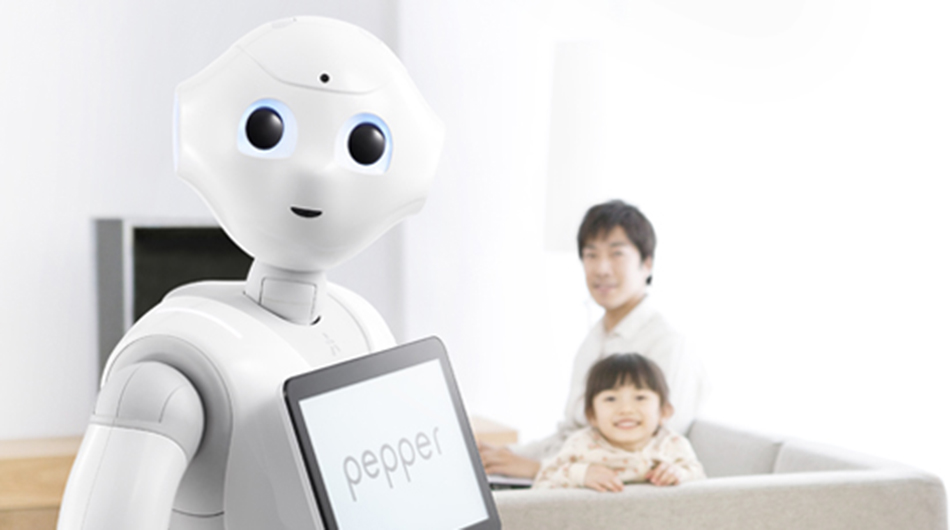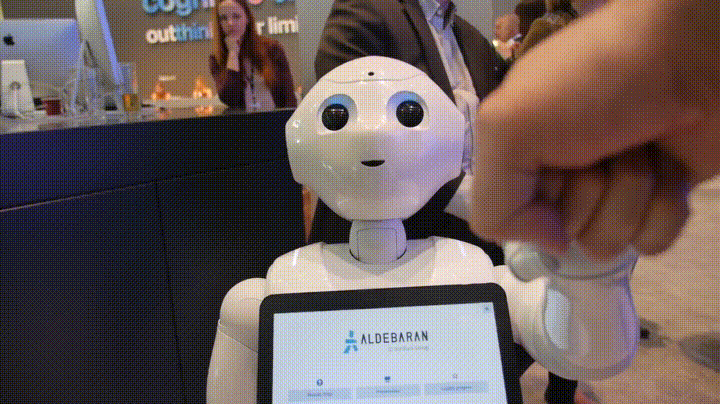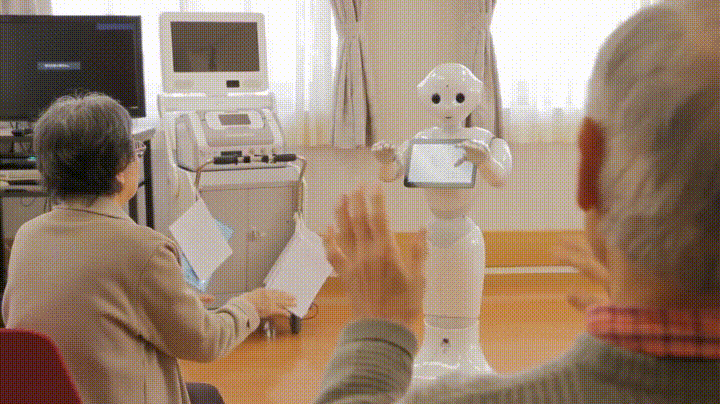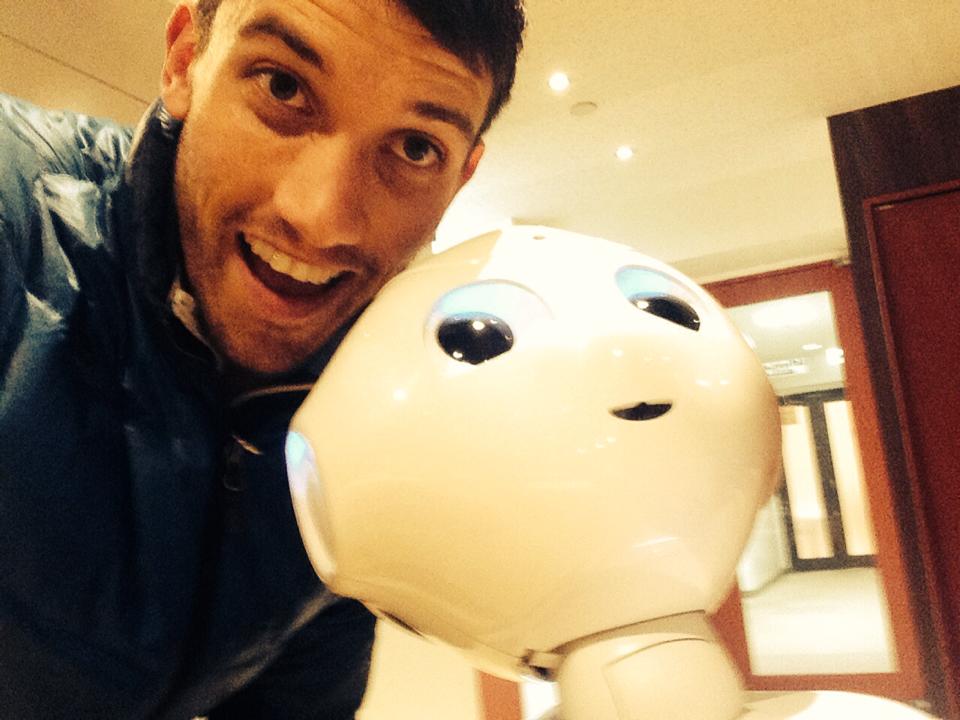
Image credit: SoftBank.
You fax some documents to the retirement home before rushing out the door to visit your mother for her birthday. You pick up a present at the store and hear one of the sales people introducing a new coffee maker in a childlike voice. Peaking around the corner, there’s a glossy white robot enthusiastically waving about and explaining the features of the machine. While sipping on a cappuccino, you browse for your mom’s favorite CD before grabbing the bullet train. On the platform another shiny robot dressed as a stationmaster is explaining to two tourists how to get into the city.
You arrive at the home a little late and ask the nurse where your mother is. She directs you to the exercise room. There’s a familiar voice coming over the speaker. Walking through the door you smile at your mother while she raises her arms up and down in time with our little robot friend in the front of the class.
2016
It’s 2016 – and the robots are clearly in charge. Albeit in a very polite and gentle way.
The soft-spoken voice belongs to Pepper, the emotional humanoid robot by Japanese internet and telecom giant SoftBank. Founder and CEO Masayoshi Son first revealed Pepper on stage in 2014 and the two have shared several public moments since.

Pepper fist bumping a conference attendee.
Years before courting ARM, SoftBank had a fling with French robotics company Aldebaran and eventually brought the firm under the SoftBank name. There are now over 10,000 Peppers in the wild, working hard.
Pepper responds to your voice, facial expressions, body language, and words. The latest version is programmed to do 28 jobs. It will soon do more as SoftBank and IBM are busily working to adapt Watson’s artificial intelligence to Pepper.
Weigh in
Pepper is about the size of the average eight-year-old. Its four directional microphones and combination of cameras, lasers, and other sensors allow Pepper to recognize objects and determine where they are coming from.
Pepper’s emotional engine is supposedly modeled after human hormones and improves daily because it is connected to SoftBank’s artificial intelligence over the internet. All the sensor data is stored in a single shared location, which allows individual Peppers to access information from previous interactions with humans and analyze various facial expressions and emotional cues. Companies are greatly interested in the insights such big data can provide.
While there is also a personal version of Pepper that can shoot the dozens in a rap battle, dance around, or talk about specific topics like sushi, “Pepper for biz 2.0” launched last month with more functions at a cost of around US$550 per month for three years.

Pepper leading a dance class at a nursing home with music from karaoke company Joysound.
The upgrade allows Pepper to do things like be the frontline salesman at a car dealership by referencing a database of cars to start the conversation, lead exercises and recreation at hospitals and retirement homes, help you get over your fear of public speaking by giving a presentation for you, and perhaps take away late-night comedian’s jobs by finding and reading tweets out loud.
Can it work, work, work, work work?
I saw the robot on a daily basis for a number of weeks at a shared office I frequented. The first day was hilarious and exciting, but daily interactions became stale and Pepper was often not working. Pepper has proved to be underwhelming and gimmicky.

Pepper and Peter BFF.
Granted, it has been several months since I personally interacted with Pepper and the new features and exhibitions I have seen lately look novel. I plan to scope out Peppers in the wild and interview customers and business owners over the next few months to see how he (Pepper in Japan is often thought of as a boy although Pepper would refer to itself as without gender) performs his new duties.
Robots will be the partner of humans.
SoftBank Robotics said in an email that Pepper is not just about marketing. He helps make sales, processes payments at restaurants, helps people queue at stores, prompts people to get check-ups at hospitals, and does translations at hotels. 80 percent of companies using Pepper are smaller companies, including some mom and pop stores.
“Robots will be the partner of humans,” says a spokesperson for the robotics department. In the future “all the decision making will be done by humans. Robots just help those decisions.”
2040
Robots have been in SoftBank’s crosshairs since 2010 when Masayoshi Son unveiled the company’s 30-year plan. We are edging closer to the day where there’s a robot in every home and humans and robots collaborate on a daily basis.
Gajan Mohanarajah is the CEO of Rapyuta Robotics and is also working on an “internet for machines.” He sees robots in the next five to ten years penetrating the market similar to the way personal computers did as costs continue to decrease.
“Since robots are good at repeating things with high speed and precision, they have a good chance to start at the assembly lines of [small and medium-sized businesses] along with humans.” From there Gajan sees robots moving into other repetitive tasks or jobs that are considered dirty or dangerous.
While Pepper is designed more to bring happiness into people’s lives, the data this current generation of robots will gather may be a pivotal base for future human and robot interactions. We should get used to the idea of working with or even having robots take over for us.
“A roboticist,” laughs Gajan at the choice of careers left for humans. “All the rest is gone. I have the safest job.”
This post Pepper the robot gets to work in Japan appeared first on Tech in Asia.
from Tech in Asia https://www.techinasia.com/softbank-pepper-robot-jobs-japan
via IFTTT
No comments:
Post a Comment